Jeronimo Lozano
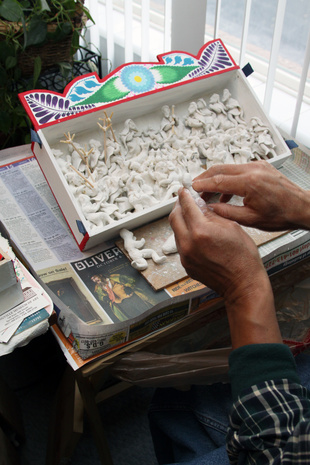
Tell us about your background.
From the time that I was a child in the village of Huamanga, Ayacucho, Peru, I was exposed to various folk art traditions of the Andes. This is an area rich in ancient Inca culture and traditional beliefs. I had a natural disposition toward art and was encouraged by my elementary school teachers to further my art education.
I was selected to attend various colegios that specialized in art training, and eventually I was admitted to the School of Fine Arts at the University of Peru.
It was during this time that I was directed back toward my indigenous heritage and was encouraged to make systematic study of the folk art traditions of the Peruvian people. For twelve years, from 1967 to 1979, I traveled throughout Peru to study and learn from the traditional folk artisans of the Andes.
In December of 1979 I returned to the city of my birth and founded an artists’ studio named Artists Workshop Guamangensis. There I worked and studied to perfect fifty different specialties of handmade Peruvian folk-crafts from all parts and peoples of Peru.

In my attempt to rescue some of the forgotten crafts of the past, I became especially interested in the art form called retablos. It’s a combination of ancient Incan and colonial Spanish art traditions in which a series of pictorial scenes are arranged in a single work to relate a mythical or historical drama. The scenes consist primarily of handmade figurines, modeled and painted to convey the appropriate sense of action, drama, or humor.
The retablo has long been loved by the common people of Peru, as it reflects their customs, beliefs, and personalities in a concise visual narrative. I have made it my specialty and have created retablos in such diverse formats as handmade wooden chests, gourds, matchboxes, sea-shells, reeds, and tree trunks. These serve as the box or container in which the various scenes are displayed. They may be decorated in a variety of ways and are usually hinged to open and close.
The original purpose of the retablo was to instruct, so I have continued this tradition by including scenes of the Peruvian people’s struggle for independence and current political events. During my years of study I also learned the traditional dances and songs of my country and frequently depict them in my retablos.
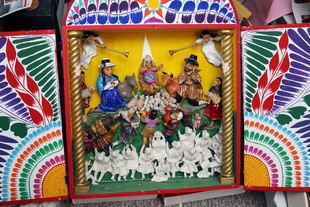
After enduring several years of harassment by terrorist groups, I was warned not to return to my village. I came to the United States as part of a performing arts group from Peru. I have since received official recognition by the U.S. Immigration and Naturalization Service as an “Artist of Extraordinary Merit.” I view myself as a cultural ambassador of the culture of my native Peru and through my retablos I wish to preserve the myths of the ancient Inca and document the traditional life of the Andean people.
Some of my recent work reflects my more recent experiences and observations of the intriguing cultural traditions of the United States.
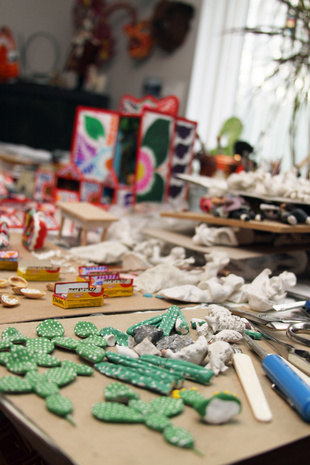
What is your favorite retablo of those you’ve done?
Perhaps my most significant work of the summer is a retablo depicting my recent surgery to place synthetic bones in my middle ear and graft a new ear drum. While recovering from this operation, I conceived of a symbolic representation of this event. The retablo that I made shows a South American llama lying on the operating table, representing me. The doctors and attendants are represented by animals typical of North America. The surgeon, in the form of a wise rabbit dressed in green surgical scrubs, is delicately lifting my ear with his scalpel while his assistants, also in green scrubs, are depicted as a deer, a buffalo, a cow and a bear. Four University of Utah medical students are observing and taking notes on the operation. They are shown as a horse, a rat, a wolf, and a duck wearing t-shirts with a large red “U” on them.
Since Dr. Clough Shelton of the University of Utah Medical Center, donated his services and Intermountain Health Care’s LDS Hospital accepted my case as a special charity, I have made two copies of this retablo and am giving one to each of them.
By the way, the operation was more successful than anyone expected and I am now able to hear birds singing again. In fact, the hearing in my left ear is now better than in my right ear.
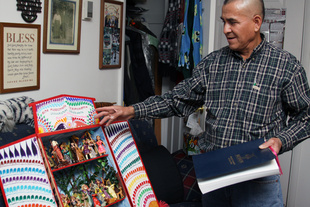
Tell us about your conversion.
When I lived in Peru, I had never heard of the LDS Church. Before I boarded the airplane to come here, I heard that they were building a church in Lima. I came in a big group of folklore artists and went to Miami, then to Salt Lake, and I saw the temple there.
After traveling around with this group, I lived with some people in Salt Lake and they would go somewhere every Sunday and I didn’t know where they were going, so one day I asked if I could go with them. When I got to church, a sister gave me a Book of Mormon and a paper of chapters for me to mark off as I read. I read the Book of Mormon in three months.
The Book of Mormon was very interesting to me, so I met some missionaries who were really good to me and taught me every week. I went to church every week and the missionaries talked to me about how I needed to be baptized because Jesus Christ was baptized, so I decided to be baptized.
On the day of my baptism, it was really dark outside, like it was going to rain. There were a lot of dark clouds everywhere. After I was baptized, after the meeting was over, I went outside and the sky was clear and the sun was shining really bright and it was such a beautiful day. It was like a miracle. My baptism was really special.
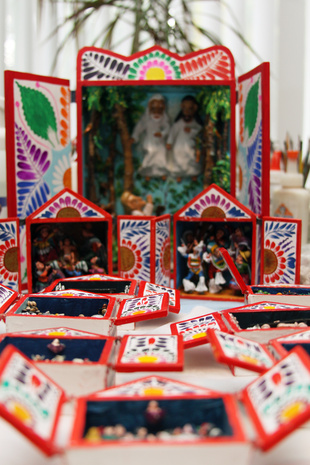
Then I learned about baptisms for the dead, so I spent a lot of time trying to find out the names of my grandparents and great-grandparents, which was hard because I had never met them. But after finding some of their names, I submitted them to the bishop and he helped me through the process of getting those names submitted so I could be baptized for them. I’ve done baptisms in the temple fourteen times so far. I felt special being able to be baptized for those people who never had the opportunity to know Jesus Christ and be baptized in his name.
Then I was given the priesthood and became a high priest.
I met a friend, Mary Agusta. She taught me about family history. She had bad health, so I had compassion for her and took care of her. Then some sister missionaries came over to teach her the gospel and she was baptized and I confirmed her in church.
After she was baptized, she was very happy, but her health deteriorated so she went to a nursing home. I visit her three times a week and take her to sacrament meeting, then I take her home and go to my sacrament meeting.
When I lived in the mountains in Peru, my mother used to be a missionary and would go around and teach about God—Catholic doctrine mostly, but I was surprised that what the LDS believed was what my mother taught me.
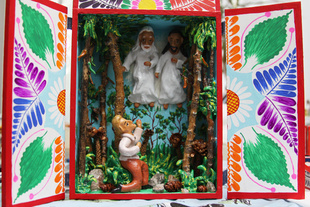
Can you explain how you make the retablos?
First, I buy flour and mix it in a little bowl with cold water very slowly, and then I also cook it slowly so it makes a paste. I take a spoonful of that paste and put it in flour and roll it around and that converts it into a plaster. It looks like clay, but it is the plaster used to make the little models.
What kind of models?
My favorite models to make are animals, plants, and different customs which are sacred. After they dry for one day, I paint them with watercolors or acrylic paint. If I didn’t have any money to buy paintbrushes, then I would make the paintbrushes out of hair. I would cut hair, maybe my hair—boy or girl, it doesn’t matter—but I just get little hairs and tie them to a little stick and use that to paint.
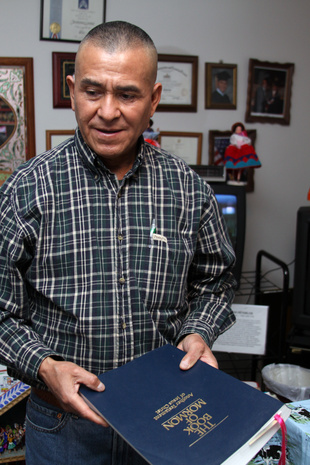
Is using real hair better?
Yes, it’s better because in the mountains we have many animals like horses, cows, dogs, and goats, so when they’re sleeping you cut their hair to use to make paintbrushes. When I lived in the mountains, I only used the natural colors. I never bought anything. I always made my own brushes and made paint out of plants, dirt and earth, fruit, things like that. And I used those for colors so all my colors were natural. Now I buy paints and brushes to paint the little figures. They work a little differently, but it’s easier now to do that.
Making your own paints sounds very hard, though.
Yes, it is difficult. It takes patience to make paint.
What happens next?
After I finish coloring and painting, I make cabinet boxes of wood, like a carpenter. I mostly make them with wood, and after I make them they need to be whitened—painted. So I paint them and paint flowers or something to decorate them.
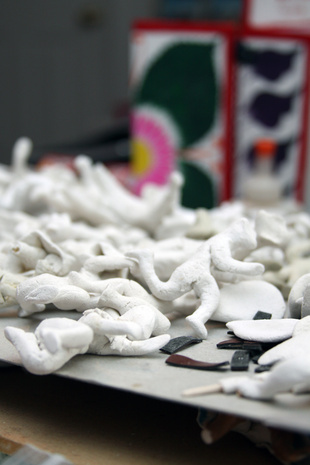
What kinds of different things have you found to make your boxes with?
Matchboxes, chicken eggs, and other different materials. Sometimes the boxes are very small so I have to make the figures small enough to fit inside.
You’ve used a chicken egg?
Yes, and an ostrich egg. I’ve used seashells too—clams. I open the shell and eat the clam, and then I use the shell to make the retablo box.
So, you paint the outside separately. You paint the cabinet—or the box or shell—and then you put in the figures?
Yes. After coloring all the figures and the painting, I glue them inside the cabinet and decide what scene to do. The figures will maybe represent a Christmas scene—a nativity—maybe folk dances, maybe history, or something happening in the community.
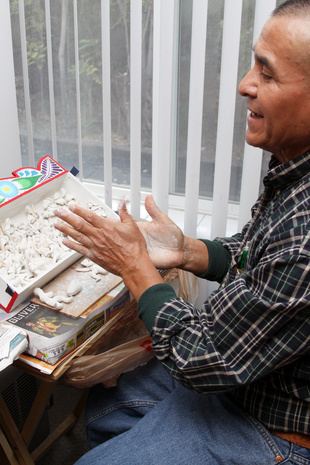
I’ve noticed you make a box for every place that you’ve gone, so for different events you kind of document them with your figures in a box.
Yes, I use them for documenting. The first model I made when I moved to Utah was of Joseph Smith and the First Vision. I also make many retablos with religious themes. I’ve made some of the pioneers crossing the plains guided by Brigham Young, and lots of Book of Mormon stories. And Bible stories, so people from many religions like my work—Catholics, Presbyterians, everybody likes the Bible stories.
What are you making now?
Right now I’m preparing for a big traditional festival at the end of the year in December, so I’m making many traditional retablos, Bible stories, and things like that for the festival.
What are your retablos representing for this festival (the Indian Art Walk)?
The Christmas customs from where I come from in the mountains, so here I am representing the birth of Christ. I am also making rodeo scenes with cowboys, Native Americans dancing, and other things.
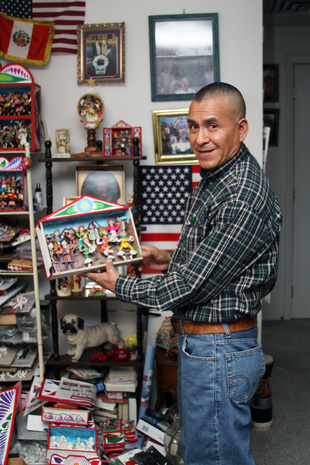
Which ones have you most enjoyed making?
I love them all, but I’m really proud of the one I made about the First Vision, and also the one of my surgery at the University of Utah.
How has the gospel affected your work?
After I was baptized, I didn’t change anything in the technical aspects or the process, but there have been changes in the type of models I make and the scenes I do because I produce a lot more gospel-related work. But I haven’t changed how I do it because you can’t change that. This type of artwork has over five hundred years of history, so it’s important to preserve it and keep it traditional.
The gospel is full of marvelous stories. They are marvelous by themselves, but I like to portray them through my work as well, and I am going to do it my whole life. ❧
